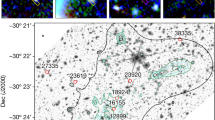Abstract
THE spectra of quasi-stellar objects are observed to have absorption lines with redshifts mostly below the redshift of the emission lines1. The absorbing clouds are thought to be either near the QSO1–5 or at cosmological distances from it6–8. On the first interpretation, the clouds are supposed to be accelerated to high velocities (≲ 0.5c away from the QSO) by radiation pressure. However, the small internal velocity dispersions inferred for the clouds from the absorption line widths (∼ 50 km s−1) pose serious problems to this model9 and we consider here the second interpretation. The interception cross section of intervening galaxies for QSO photons has hitherto been calculated10 on the assumption that the galaxies do not evolve. The data so far available (Fig. 1), although probably contaminated by selection effects1, seem to indicate that the number of absorption redshift systems increases more rapidly as a function of the emission line redshift than can be accounted for without such evolution. The possibility has been considered7,8 that the intervening clouds are collapsing protogalaxies, but we think it likely that most galaxies form11 before z = 5 and, instead, attribute the rapid increase in the number of redshift systems to tidal interaction of galaxies at earlier epochs. Because galaxies were closer together in the past, chance collisions were more frequent and the effects of these interactions were more pronounced.
Similar content being viewed by others
References
Burbidge, E. M., and Burbidge, G. R., Astrophys. J., 202, 287–295 (1975).
Boksenberg, A., and Sargent, W. L. W., Astrophys. J., 198, 31–43 (1975).
McKee, C. F., and Tarter, C. B., Astrophys. J., 202, 306–318 (1975).
Wingert, D. W., Astrophys. J., 198, 267–279 (1975).
Weymann, R., Commun. Astrophys. Space Phys., 5, 139–150 (1973).
Bahcall, J. N., Astron. J., 76, 283–290 (1971).
Arons, J., Astrophys. J., 172, 553–562 (1972).
Röser, H.-J., Astron. Astrophys., 45, 329–333 (1975).
Kippenhahn, R., Perry, J. J., and Röser, H.-J., Astron. Astrophys., 34, 211–224 (1974).
Wagoner, R. V., Astrophys. J., 149, 465–476 (1967).
Jones, B. J. T., Rev. Mod. Phys., 48, 107–149 (1976).
Peebles, P. J. E., and Hauser, M. G., Astrophys. J. Suppl., 28, 19–36 (1974).
Toomre, A., and Toomre, J., Astrophys. J., 178, 623–666 (1972).
Roberts, M. S., in External Galaxies and Quasi-stellar Objects: IAU Symp. No. 44, (edit. by Evans, D. S.), 12 (Reidel, Dordrecht, 1972).
Bahcall, J. N., Astrophys. J., 200, L1–L3 (1975).
Author information
Authors and Affiliations
Rights and permissions
About this article
Cite this article
COTTRELL, G., ICKE, V. Interacting galaxies and QSO absorption lines. Nature 264, 733–734 (1976). https://doi.org/10.1038/264733a0
Received:
Accepted:
Issue Date:
DOI: https://doi.org/10.1038/264733a0
- Springer Nature Limited





